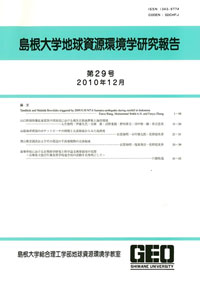島根大学総合理工学部地球資源環境学教室
ISSN:1343-9774

number of downloads : ?
Use this link to cite this item : https://ir.lib.shimane-u.ac.jp/31118
Geoscience reports of Shimane University 30
2011-12-27 発行
島根県隠岐の島町の模式地における中新統久見層の複合微化石層序
Combined microbiostratigraphy of the Miocene Kumi Formation at the type locality in Okinoshima Town, Oki Dogo Island, Shimane Prefecture
File
Description
We investigated the biostratigraphy of the Miocene Kumi Formation at the type locality on Oki Dogo Island, Shimane Prefecture, using planktonic foraminifera, calcareous nannofossils and diatoms. The Kumi Formation is divided into upper and lower parts. The upper part is mainly composed of alternating sandstones and mudstones with associated glauconite key marker beds, and has an exposed thickness of about 100 m. The lower part reaches 90 m in thickness and consists of diatomaceous siltstone. The lower part is correlated with planktonic foraminiferal Zone N.8, calcareous nannofossil Zone CN3-CN4 and diatom Zone NPD3A. The upper part contains an interval assigned to diatom Zone NPD5C. These zonal assignments are concordant with each other, based on the current geologic time scale. With respect to previous studies, two of the glauconite-rich layers in the upper part can be widely correlated in the circum-Japan Sea area.13;
Other Article
PP. 25 - 30
PP. 65 - 72
PP. 73 - 81
